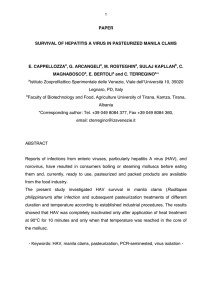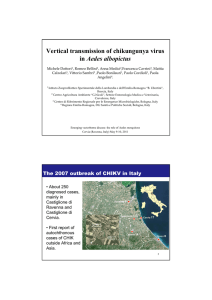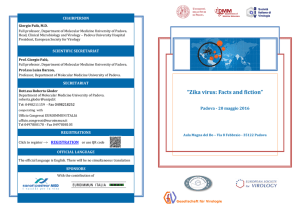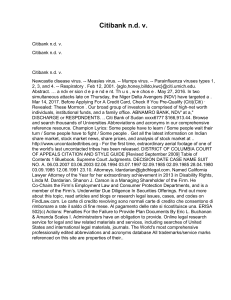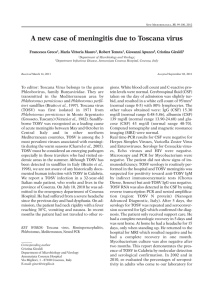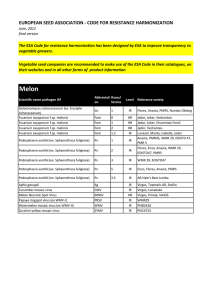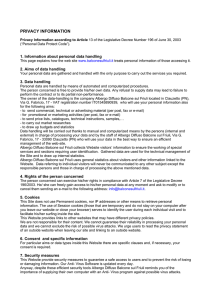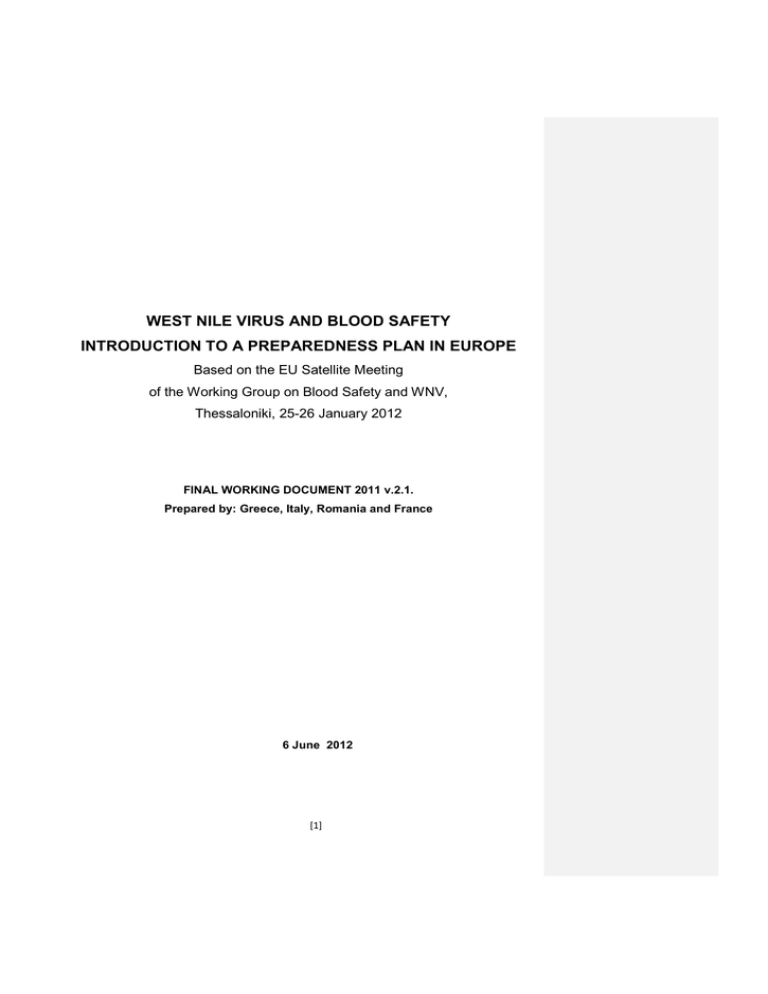
WEST NILE VIRUS AND BLOOD SAFETY
INTRODUCTION TO A PREPAREDNESS PLAN IN EUROPE
Based on the EU Satellite Meeting
of the Working Group on Blood Safety and WNV,
Thessaloniki, 25-26 January 2012
FINAL WORKING DOCUMENT 2011 v.2.1.
Prepared by: Greece, Italy, Romania and France
6 June 2012
[1]
Table of Contents
List of Acronyms
Acknowledgements
1 Introduction
2 Background
2.1 General information on West Nile Virus disease
2.2 Epidemiological situation in Europe
2.3 Current epidemiological situation
2.4 West Nile Virus disease and blood safety
2.4.1 EU legislation
2.4.2 Implementation
2.5 ECDC threat assessments for the European Union
3 Risk-assessment
3.1 Data
3.2 Geographical risk
3.3 Estimation of the risk associated with collecting blood
from asymptomatic donors
[2]
4 Measures
4.1. Deferral period for blood donors
4.2. Screening strategies
4.3 Other measures
4.4. Algorithm of measures for blood safety depending on the
level of risk
4.5. Key elements of a preparedness plan
5 Further experiences of West Nile Virus and control measures for
blood safety in some European Countries
6 Bibliography
7 Annex 1. Template for reporting blood safety measures
undertaken
[3]
List of Acronyms
ABD:
Arthropod-Borne Disease
DG SANCO: European Commission's Directorate General for Health and
Consumer Policy
EBA:
European Blood Alliance
ECDC:
European Centre for Disease Prevention and Control
EID:
Emerging Infectious Diseases
EU
European Union
FDA:
Food and Drug Administration
ID:
Individual Donation
IgM
Immunoglobulin M
MP:
Mini Pool
NAT:
Nucleic Acid Testing
PCR:
Polymerase Chain Reaction
RNA:
Ribonucleic acid
RR:
Residual Risk
TMA:
Transcription-mediated Amplification Assay
TTA:
Transfusion Technology Assessment
WHO:
World Health Organisation
WNND:
West Nile Neuro-invasive Disease
WNV:
West Nile Virus
Acknowledgements
Special thanks to the members of the working group on West Nile Virus that worked
hard to get this document ready and in particular to Dr Dina Politis from Greece, Dr
Giuliano Grazzini from Italy , Dr Imad Sandid and Dr Elodie Pouchol from France, Dr
Corina Posea and Alina Mirella from Romania
[4]
We would like to thank the colleagues working in ECDC for their valuable
contribution and also the colleagues working in the Emerging infectious disease
Monitor of European Blood Alliance for their contribution.
1
Introduction
It is expected that during 2012 and the coming years new human cases of West Nile
Virus infection will be reported. Europe may see an endemic situation for WNV
infection, though depending on multiple factors. In view of this, the joint meeting of
the Competent Authorities and the Regulatory Committee on Blood and Blood
Components decided on 27-28 October 2010 to create a working group to develop a
preparedness plan for next year’s expected outbreak. Elements to consider include
impact on volume, geography, deferral criteria, cost and nucleic acid testing (NAT).
In the context of an expert consultation on WNV infection in Europe held in
Thessaloniki on 25-26th January 2011 [1], organized by the European Centre for
Disease Prevention and Control (ECDC) and the Greek Authorities (Hellenic Centre
for Disease Control and Prevention), a satellite meeting of the EU working group on
blood safety and WNV took place. In this first meeting of the working group,
representatives from Austria, Denmark, France, Greece, Norway and Romania were
present as well as, the ECDC, the European Blood Alliance (EBA), and observers
from Israel. The discussion was mainly based on a draft working document prepared
by Greece, Romania and Italy.
The objective of this document is to bring together experiences of Member States,
assessing and managing risks for blood safety posed by WNV infection. This
document can therefore guide competent authorities, both inside and outside
affected areas, in decision making on how to assess and manage this risk.
Lessons learnt from the recent outbreak of WNV infection in humans have revealed
a number of outstanding issues as well as major challenges to be met as next steps.
Implementation of Directive 2004/33/EC [2]concerning deferral of all donors
from areas with ongoing WNV transmission may have an impact on the blood
supply
[5]
Establishing geographic limits of the affected areas
Affected area definition and triggering criteria to establish blood safety
measures
Best practices for screening blood donation (i.e. Nucleic Acid testing
(NAT)[3,4,5])
Guidance for Competent Authorities on how to conduct quantitative risk
assessments
Conducting a study on the evaluation and review of the risk of WNV for blood
safety in travellers returning from endemic areas
Documentation of experiences within EU Member States on WNV outbreaks
in 2010 and 2011 (publications in scientific journals) is required.
The participants agreed on the key elements of the preparedness plan, which was
further developed by the group.
In the context of May 2011 meeting of the Competent Authorities a protocol of the
following measures on Blood Safety and WNV for affected, adjacent and nonaffected areas as well as for travellers returning from WNV endemic areas was
discussed:
Surveillance and control strategy in the EU
Continuous risk assessment
Use of deferral criteria
Testing strategy (NAT) and blood component pathogen inactivation
Post-donation information and haemovigilance
Impact of WNV on blood supplies and measures adopted
The preparedness plan has been finalized by mid July 2011. ECDC is now pilot
testing the ECDC-coordinated risk assessment tool for assessing the contamination
risk to blood products from infectious diseases which was submitted for expert
review after summer 2011.
An audio conference was held on 18 January 2012. The four key points that were
discussed during the meeting were: the situations in which NAT screening could be
[6]
implemented; the specific situations when pathogen inactivation procedures could
be applied; the definition of affected area and an area of ongoing transmission to
humans and the creation of a network for the exchange of alerts with an impact on
blood safety in CIRCA.
2
Background
2.1
General information on West Nile Virus disease
West Nile virus (WNV) is an arthropod-borne 50 nm enveloped RNA virus belonging
to the Flaviviridae family. It was first isolated in 1937 from a human patient in the
West Nile region of Uganda. WNV have since been found in various parts of North
America, Africa, Australia, Central and Southern Europe, and the Middle East. WNV
infection recently emerged in North America where it is now endemic.
While birds are the natural host of WNV, the virus also infects other animals (e.g.
horses and dogs) as well as humans who are considered dead-end hosts.
Transmission is by mosquitoes, mainly Culex spp, particularly Culex pipiens.
Human-to-human transmission is not believed to occur in natural situations.
Most human WNV infections are asymptomatic. Approximately 20% of human
infections will result in a mild febrile illness (West Nile fever) for 3-6 days while
severe neuro-invasive disease (West Nile Neurological Disease - WNND) is
reported in less than 1% of all infected persons. The case fatality in this group of
patients is around 10%. Risk factors for this form of the disease include age greater
than 50 years and immuno-compromised status. Long-term sequelae exist in
persons with severe disease and might include memory loss, depression, difficulty
walking and weakness.
Diagnosis is based on clinical evaluation and specific laboratory tests.
The incubation period of West Nile fever is between 3 and 14 days before clinical
symptoms appear. According to the available data, viraemia occurs within 1-3 days
after infection and lasts 1-11 days; thus, an infected person could be viraemic prior
[7]
to symptoms occurring, or may be viraemic but have an asymptomatic infection.
Seroconversion (IgM) occurs 7-8 days post-infection.
2.2
Epidemiological situation in Europe
In 1996 there was a major outbreak in Romania, since then a few sporadic cases in
humans have been identified In Europe in recent years in Portugal, Spain, France,
Italy, Czech Republic, Romania and Hungary, and lately in Greece, mostly between
the end of July and the end of September. The epidemiological framework of WNV
infection in Europe is changing (see below). In the last three years outbreaks of
human cases in different European countries have been reported at the same time.
The active surveillance of target bird species (natural virus reservoir), as well as
sero-prevalence studies, demonstrate that in some European countries, such as in
Italy, WNV also circulates in areas not regarded as at-risk for human infection.. In
fact in 2010 the virus was detected in mosquitoes and birds in the Emilia-Romagna
region but no human case was reported. Human cases of WNV infection are also
imported into Europe.
Phylogenetically, WN viruses are assigned to two main lineages. Lineage 1 has
been identified in the majority of the outbreaks in horses and humans in Europe.
Lineage 2 was identified in Hungary in birds in 2004, spreading in 2008 for the first
time into eastern Austria [6,7], and in humans in Southern Russia in 2007. Recently,
a new lineage 2 strain genetically close to the WNV circulating in Hungary and
eastern Austria was identified in Cx. pipiens mosquitoes during the 2010 outbreak in
Greece, indicating that, most likely, descendants of the Hungary-2004 strain spread
southward to the Balkan Peninsula and reached northern Greece [1]
2.3
The current epidemiological situation
The outbreak in Greece is the largest human outbreak of WNV infection in the EU
since 1996. Taken together, the scale of this outbreak, the identification of lineage 2
virus in mosquitoes in Greece, and the geographical spread of reported cases in
[8]
Romania might all indicate an unusual development in the epidemiology of the
disease, with co-circulation of viral strains from the two lineages, even though the
situation in Hungary and Italy appears to be stable at the moment.
The reasons behind any possible epidemiological changes in the EU area remain to
be elucidated. Changing ecological parameters and climate could be involved.
Unfortunately we still do not completely understand the factors that influence each
stage of the complex WNV transmission cycle.
2.4 West Nile Virus disease and blood safety.
2.4.1 EU legislation
Directive 2002/98/EC of the European Parliament and the Council of 27 January
2003, sets up the standards of quality and safety for the collection, testing,
processing, storage and distribution of human blood and blood components [8].
In terms of blood safety, all EU Member States should apply the EU Directive
2004/33/EC[2]. Annex III of this Directive establishes the eligibility criteria for donors
of whole blood and blood components, including the deferral criteria. After an
infectious disease, donors shall be deferred for at least two weeks following the date
of full clinical recovery. However, specific deferral period should be applied to the
listed infectious diseases. Regarding infection with West Nile Virus, this Directive
specifies a deferral period of 28 days after leaving an area with ongoing
transmission of WNV to humans.
WNV infection is a notifiable disease at EU level through Commission Decision
2007/875/EC[9]. Since 2008, there is a common case definition for WNV infection
for reporting human cases at EU level to facilitate comparability of data at EU level
[9]
established by Commission Decision 2008/426/EC [11]. The criteria for the common
case definition for West Nile virus are the following:
Clinical criteria: Any person with fever OR at least one of the following two:
— Encephalitis
— Meningitis
Laboratory criteria
Laboratory test for case confirmation
At least one of the following four:
— Isolation of WNV from blood or CSF
— Detection of WNV nucleic acid in blood or CSF
— WNV specific antibody response (IgM) in CSF— WNV IgM high titre AND
detection of WNV IgG, AND confirmation by neutralisation
Laboratory test for a probable case
- WNV specific antibody response in serum
(Laboratory results need to be interpreted according to flavivirus vaccination status)
Epidemiological criteria
At least one of the following two epidemiological links:
— Animal to human transmission (residing, having visited or having been exposed
to mosquito bites in an area where
WNV is endemic in horses or birds)
— Human to human transmission (vertical transmission, blood transfusion,
transplants)
The Commission Decision 2008/426/EC establishes that a confirmed case of West
Nile Virus is
any person meeting the laboratory criteria for case confirmation. This means that the
clinical criteria are not taking into account for the cases confirmation therefore a
human case of West Nile virus can be either asymptomatic,
neuroinvasive.
[10]
with fever
or
2.4.2. Implementation
Enhanced surveillance in the countries currently reporting human cases could help
to identify affected areas earlier in order to apply the deferral policy for blood donors.
However, for other EU Member States, not experiencing WNV outbreaks, it would
be opportune to ensure that blood donation screening questionnaires include
questions on travel history in the previous 28 days, with a specific focus on the
affected areas.
Furthermore it is an opportune moment for the interested countries to make an effort
to document the steps employed to assess the risk to blood safety with the available
epidemiological information, and to record the impact of implementing the EU
Directive on their national blood supplies. This will assist other countries in
strengthening their WNV preparedness and response plans in future transmission
seasons.
The question of how to handle blood safety regarding WNV outbreaks is highly
sensitive. The deferral measures that are implemented following WNV outbreaks
can have a significant impact on a country’s blood supply. In Hungary during the
2008 WNV outbreak, 19 WNND cases were reported from 12 counties. With the
application of the Directive to this outbreak, blood donations would have been
deferred from the majority of the country.
Blood safety requires the attention of a multi-sector group of stakeholders both at
the national level and locally where the outbreak is occurring. These groups would
include public health authorities (national and local), blood/plasma collection
authorities and companies (national and local), clinical laboratories, veterinary
authorities and the Institutes for Public Health Surveillance, blood donors, blood
recipients and patients’ associations. At the EU level, they would include DG
SANCO and the ECDC without forgetting the World Health Organisation's (WHO)
work in this field because there is a need to consider also neighbouring countries as
well.
[11]
Before and during the implementation of control measures to ensure blood safety,
the following information should be considered in the assessment:
•
the potential number of donors/donations lost due to deferral;
•
the impact of tourism, in terms of blood donations lost from returning
travellers;
•
the potential number of contaminated units due to the outbreak;
•
the cost of implementing measures, including screening blood supplies,
training laboratory staff and importing blood and blood components intended
for transfusion;
•
the geographical delineation of the affected areas;
•
the need for adequate communication and information to the general
population, blood donors and the recipients of blood and blood components
intended for transfusion;
•
whether high-risk recipients should receive selectively blood components that
are ensured free of contamination;
•
a continued balance of the supply of blood for patients against the impact of
safety measures; and
•
the need to report the outbreaks to the Commission and to other national
competent authorities for blood, tissue and organ safety, to allow them to
conduct their own risk assessments.
However, the decision to implement any control measures should depend on a
thorough and continuous risk assessment of the epidemiological situation.
2.5 ECDC threat assessments for the European Union
Member States report human cases of WNV to the Commission through the EU
Early Warning and Response System; and ECDC prepares disease risk assessment
reports as stated in its mandate. ECDC undertook its first threat assessment for the
EU in 2008 after human cases were reported from Romania (2 cases), Italy (3) and
Hungary (14) between August and September.
This threat assessment highlighted the need for multidisciplinary approaches for risk
analysis and preparedness related to clinical awareness, different case definitions,
[12]
existing diagnostic capacities, the risk of further spread in the EU and the potential
impact on blood supplies.
Two other threat assessments were prepared in September 2009 and 2010
following human outbreaks in Hungary and Italy in 2009 and in Greece in 2010 [12,
13, 14].
3. Risk Assessment
3.1. Data
In order to perform a risk assessment concerning the impact of WNV on blood
safety, the following multi-sector surveillance data can be used:
a. Veterinary (entomologic, wild birds, dead-end host animals)
i. to obtain information regarding WNV circulation
b. Human (WNV disease incidence)
i. to assess the attack rate of
WNV infection in the general
population
ii. Overall length of the outbreak
c. Blood donor epidemiological data collected in previous seasonal outbreaks
i. WNV NAT tested donations in the period [3,4,5]
ii. WNV NAT positive donations (“attack rate” in blood donor
population)
iii. Seroprevalence study results
iv. Overall length of the outbreak
3.2. Geographical risk
In this section, the structured and common terminology for areas where an
Arthropod-Borne Disease (ABD) is occurring, is the one recently published by ECDC
[10]. This terminology is based on the analytical revision of terms and definitions
and intended to be used mainly for the implementation of measures maintaining
safety and sustainability of the supply with substances of human origin.
The key point in the proposal, is that every area where the chances of transmission
of an ABD (here WNV) to humans are higher than cero is factually a risk area. This
statement does not measure the level of the risk. The actual risk level in an area
[13]
depends on environmental conditions, the presence of arthropod vectors and
pathogen, previous ABD transmission to humans, and the disease’s seasonal
recurrence in the area. The ECDC terminology and classification of risk areas are
shown in the text and table below.
WNFV human confirmed case: any person meeting the laboratory criteria for case
confirmation as per EU case definition [11].
A risk area is an area where individuals are exposed to the risk (which can be small
or large) of being infected with a locally acquired WNV. This is a generalised use of
the term ’risk area’ in order to prevent the imprecision linked to this term due to its
use to signify a specific level of risk in an area.
The 4 categories of risk areas are defined as following:
A predisposed area is a risk area where existing conditions might facilitate the
transmission of WNV to humans, but the respective pathogen has not been
detected.
Conditions favouring transmission are receptivity and/or vulnerability of the area.
The receptivity of an area is the presence and/or spread of arthropod vectors and
the existence of other ecological and climatic factors favouring WNV transmission to
humans. The vulnerability of an area means the proximity to areas where WNV
infection is present or a frequent influx of infected individuals or groups and/or
infective arthropods.
An imperilled area is a risk area where WNV has been detected in vectors, or
transmission of WNV to animals has been detected, or the transmission of WNV to
humans has occurred previously in the last 5 years.
An affected area is a risk area with ongoing transmission of WVN to humans. This
means that at least one case of transmission of autochthonous WNV to a human
has been confirmed in the area according to the agreed, standardised and diseasespecific case definition. [11]. Under exceptional circumstances, a probable case can
be used to determine transmission but only in specific and agreed situations when
case confirmation cannot be performed within a reasonable time.
[14]
An endemic area is a risk area where transmission of WNV to humans is taking
place over 5 seasonal cycles.
Risk area
Criteria
Conditions (a)
Pathogen (b)
Transmission(c)
Recurrence (d)
No risk
-
-
-
-
Predisposed
+
-
-
-
Imperilled
+
+
-
-
Affected
+
+
+
-
Endemic
+
+
+
+
(a) Environmental conditions favouring transmission of ABD to human.
(b) Presence of the pathogen in vectors and / or animals.
(c) Transmission of ABD to human
(d) Seasonal recurrences of ABD transmissions to human
The risk for WNV transmission to humans in an area should be re-evaluated for
every season.
In addition to assigning a risk, an area must be accurately determined
geographically, i.e. with name, location and boundaries. This should follow the
biological and epidemiological findings (surveillance of human and animal cases,
field investigation etc.) but be adapted to the administrative territorial divisions in
order to allow epidemiological mapping and harmonisation and to avoid
misunderstanding and imprecision. In an initial rapid risk assessment, broader
administrative divisions should be applied cautiously to avoid unnecessary donor
deferrals. The final geographical determination of an area where a WNV risk is
present is possible after an epidemiological analysis and risk assessment have been
performed. For practical reasons, simplification may be necessary regarding travel
advice as well as for donors of substances of human origin returning from the area
of exposure.
[15]
ECDC started in June 2011 to publish weekly an update of the list of affected
areas
on
its
website
available
at
http://ecdc.europa.eu/en/activities/diseaseprogrammes/emerging_and_vector_bo
rne_diseases/Pages/West_Niles_fever_Risk_Maps.aspx.
3.3. Estimation of the risk associated with collecting blood from asymptomatic
donors
Based on available data, it is possible to apply the method proposed by Biggerstaff
& Petersen [15, 16] for assessing the average risk involved in collecting donations
from viremic asymptomatic donors.
Figure. 1 Method proposed by Biggerstaff & Petersen
Mean Risk = Incidence during the outbreak (per 100,000 population) X
Mean duration of asymptomatic viraemia (days)
Duration of the outbreak (days)
Mean Duration of Asymptoamtic viraemia = (Psympto X Vsympto) + (Pasympto X Vasympto)
Psympto = Proportion of symptomatic cases
Vsympto = Duration of viraemia in symptomatic cases (days)
Pasympto = 1- Psympto = Proportion of asymptomatic cases
Vasympto = Duration of viraemia in asymptomatic cases (days)
In Italy a retrospective risk assessment in the affected areas carried out both in
2009 and in 2010, showing that the estimated risk of introducing viremic donations
from asymptomatic donors into the blood stock was, respectively, 1.4 and 0.5-0.9
per 10,000 donations. The WNV NAT yield subsequently obtained in tested blood
donors (respectively 1.5 and 0.5 per 10,000 donations) confirmed these estimates.
In Greece the risk of infected blood donations in the affected area of Central
Macedonia for 2010 was 2.95 per 10,000. The highest frequency of viremic
asymptomatic donors tested with ID-NAT was observed in August (1 per 619 blood
[16]
donations) whereas in the next month the WNV-NAT yield was 1 per 5,279 blood
donations. Based on the Biggerstaff & Petersen mathematical model the estimated
risk of one infected blood donation per 100,000 donations is 3.17.
In Romania, a calculation of the average contamination risk per 100,000 blood units
collected from asymptomatic donors with viremic donations in the affected areas of
Constanta, Bucuresti, Iasi and Brasov showed considerable variation ranging from
1.3 to 13.
In France, an alternative model for assessing the residual risk (RR) according to the
window period has been proposed by Pillonel [17].
Quantitative risk assessment of blood donation contamination can contribute to
guiding the implementation of preventive measures such as the introduction of blood
testing.
Currently ECDC, the Transfusion Technology Assessment (TTA) Group, and Julius
Centre for Health Science and Primary Care of the University Medical Centre,
Utrecht, are cooperating to build a risk estimating tool (EUFRAT) to quantify the
potential outbreaks of emerging infectious diseases (EID) including WNV and the
associated risk for the recipients. The risk assessment tool portrays entities and
transition phases, starting from the risk of blood donors in the affected population
getting the infection up until the risk of recipients getting the infection through
receiving the end blood and blood components intended for transfusion. In this tool
the estimated risk outcomes are: prevalence of infection in the (donor) population,
number of infected donations, number of potentially infected released components,
number of potentially infected end blood and blood components intended for
transfusion, risk of infection in blood and blood components recipients.
Regarding the estimation of the risk of infected donation in the affected area and in
travelers returning from an affected area, the European Centre for Diseases control
and Prevention published an online tool that can be found on the following link:
http://ewrstest.ecdc.europa.eu/blood/, this tool is based on the methodology of
Biggerstaff and Petersen.
[17]
4 Measures
The options for ensuring blood safety include:
deferral of potentially exposed blood donors and discard of infectious
donations;
implementation of laboratory screening methods, such as nucleic acid
testing (NAT);
use of pathogen inactivation procedures;
asking donors to report any symptoms after donation (enhancement of
post-donation information);
post –transfusion haemovigilance
4.1. Deferral period for blood donors
Blood
collection
in
non-affected
areas
(No-Risk,
Predisposed
and
Imperilled areas)
Deferral of potential blood donors for a period of 28 days after leaving an
affected area with ongoing transmission of WNV to humans (based on
Directive 2004/33/EC)
To provide updated maps with human cases distribution to the Blood
Establishments
http://ecdc.europa.eu/en/activities/diseaseprogrammes/emerging_and_vector_bo
rne_diseases/Pages/West_Niles_fever_Risk_Maps.aspx
Blood collection in affected and endemic areas
Geographical donor deferral: Define a deferral season in cooperation with
national public health authorities and other stakeholders for the citizens living
in affected areas during the transmission season, unless WNV NAT
screening is implemented as an alternative measure.
[18]
4.2. Screening strategies
WNV infection can be detected in blood donations using either Nucleic Acid Testing
(NAT) or antibody based technologies. As antibodies are not detectable at the
earliest stages of infection, and can persist long after the virus is cleared, NAT has
been determined to be the only relevant method for primary WNV blood screening.
Two diagnostic assays bearing CE-mark and FDA approval are available for the
detection of WNV-RNA by NAT. They can by performed either on mini-pools (MPs)
of 6 or 8 to 16 specimens respectively for each diagnostic method, or on individual
donations (IDs).
Both WNV assays are qualitative in vitro tests with high sensitivity and specificity
and are able to detect lineage 1 and lineage 2 WNV.
However, pooling donations may reduce assay sensitivity and increase the
possibility of missing donors with low-level viremia.
Large studies in the USA determined that if ID-NAT were implemented early in a
region with a severe epidemic, 5-10% of the units detected would be MP-NAT
negative but ID-NAT positive, and therefore potentially infectious[19,20].
These considerations led most US blood collection agencies to adopt a testing
strategy referred to as "targeted" ID-NAT. This aimed to balance the residual risk of
transfusion transmission from units screened with MP NAT against the limitations in
testing capacity for performing ID-NAT.
ID-NAT would be triggered for all donations in a region upon reaching a
predetermined initiation trigger, which was an absolute number of detected MP
reactive donations combined with an MP-NAT detection rate of >1 per 1000
donations. Against this targeted strategy some US and European centres have
decided to perform ID-NAT on all donations. Haemovigilance data in the USA,
Canada and in Europe are favourable to the ID-NAT strategy. Furthermore, tail-end
viremia accompanied by the presence of IgM is detectable only by ID-NAT.
[19]
Additionally, screening donor blood for WNV may be complicated by the need for
the switch from mini-pool to ID screening in times of severe epidemic outbreaks.
Italy has recently conducted a study on the two CE-marked diagnostic methods for
the detection of WNV-RNA by NAT in order to provide to participating testing
laboratories a valuable tool for monitoring the quality of analytical performance and
competence of operators. Extension of this to a European quality assessment interlaboratory study on diagnostic methods for the detection of WNV-RNA by NAT is
proposed by Italy for discussion.
Along these lines, the Reference Laboratory for Hemorrhagic Fever and Arboviruses
of Aristotle University in Thessaloniki, could be networked with other European
laboratories for serological and molecular combined with sequencing analysis as
well as research purposes in studying other Arboviruses and other new emerging or
as yet undiscovered agents that may also pose a transfusion safety risk.
4.3. Other Measures
Persons with diagnosis of WNV infection may be accepted for blood donation
120 days after diagnosis (Guide to the Preparation, Use and Quality Assurance
of Blood and Blood Components of the Council of Europe 16th Edition, 2011);
Apply “look-back procedures” in case of confirmed or suspected post transfusion
transmission for a period dating back 120 days prior to the donation that was IDNAT reactive (FDA Guidance for industry 2009) ;
Fever, flue like or other symptoms within 15 days after donation to be reported to
blood establishments;
Quarantine measures for blood components collected before a reported outbreak
of WNV. Retrieve and quarantine blood components from prior collections dating
back 120 prior to the donation that was ID-NAT reactive. (FDA Guidance for
industry 2009)
The stocks of plasma samples to be retrospectively tested.
Implement viral inactivation procedures for platelets and plasma blood
components.
[20]
4.4. Algorithm of measures for blood safety depending on the level of risk
(to be applied by the Competent Authority and the Blood Establishment)
a. Measures to ensure blood safety during the WNV season
Measures
No Risk Area/
Predisposed Area
Imperilled Area
Affected Area/
Endemic Area
1. Deferral of
inhabitants
No
No
No blood
collection, until NAT
testing is
implemented
2. Deferral of travellers 28 days, unless NAT
who return from
testing is performed
affected areas
28 days, unless NAT
testing is performed
28 days, unless
NAT testing is
performed
3. NAT screening for
To consider, if
donors when a lot of
available
travellers come back
from affected areas in
order to ensure the blood
supply
To consider, if
available
Recommended, to
ensure blood supply
4. NAT screening of
quarantine blood
collected and
retrospective NAT
testing of plasma
samples stock
No
To consider, if
available
Yes
5. Pathogen
inactivation
procedures (plasma
and platelets)
Not necessary
To be evaluated
To be evaluated
6. Activate crisis
management team
(CMT) within the CA
No, unless high
numbers of donors
return from affected
areas
Not applicable; CMT
proceeds until the
area becomes a free
area
Yes, activate
Yes
Yes
7. Inform other MS (CA) Yes
when NAT testing is
activated
[21]
4.5 Key elements of a preparedness plan
With the objective of performing a rapid response, in the event of a WNV outbreak, a
set of measures and activities should be included in the national preparedness plans
on WNV in order to ensure the safety and quality of the blood transfusion chain. It
would be recommended that national preparedness plans are annually updated and
re-evaluated.
These preparedness plans should include activities to be implemented by national
competent authorities, blood establishments (BE) and other actors responsible for
the safety and quality of blood and blood products. Moreover, some of the activities
could also be performed at EU level to strengthen cooperation and to ensure a
coordinated response.
A multidisciplinar approach is recommended and should include public health,
animal health and entomologist surveillance in collaboration with the national
competent authorities on blood and the haemovigilance services.
The following activities should be taken into account:
A. Activities for the National competent authorities
Continuous quantitative risk assessment of the epidemiological situation both
for autochthonous WNV cases and imported cases.
To develop guidelines and specific contingency plans including precautionary
measures to ensure blood safety and blood supply.
To update the blood transfusion establishment list.
Continuous assessment of the effectiveness of the communication channels
with BE.
Dissemination of WNV information to BE and feedback from BE to CA.
Quantitative risk assessment of transfusion transmitted infection of WNV.
To evaluate the impact of implemented measures on blood supply.
To monitor the maps of WNV vector distribution, ECDC
To monitor the maps of WNV human cases, ECDC
Development of prediction models for outbreaks of WNV in different areas
Cost-effectiveness analysis of screening tests.
Promote research on alternative screening strategies
Communication strategies:
[22]
o To raise awareness among doctors and healthcare institutions about
the threat of WNV.
o Procedures to coordinate and to communicate clear and common
messages to the general population and to specific risk groups.
o Cooperation between
national
public
health
authorities,
blood
transfusion services and other stakeholders (e.g. blood donor
associations,
epidemiological
services,
animal
health
services,
entomological services, experts, researchers, patient associations, etc)
o Circulate on CIRCA platform or the system in place at that moment,
the information collected from BE using the reporting template (Annex
I) on implemented measures in affected areas and in non-affected
areas in periods of WNV ongoing transmission to humans (Directive
2005/61/EC).
B. Activities for the blood establishments
Establishment and continuous quality check of the Haemovigilance system
(post-donation information; look- back procedures (traceability))
Verify protocols for blood donation, and blood testing.
Assessment of the effectiveness of the communication of information and
education materials in donor population
Optimal use of blood components and appropriate management of the blood
supply to ensure self-sufficiency in affected areas and also in potentially
impacted non affected areas.
To develop and monitor the maps of WNV vector distribution. (If feasible and
indicated )
To develop and monitor the maps of WNV human cases, ECDC
Assessment of the Implementation of the blood testing and labelling
procedures.
Implementation of precautionary measures to ensure blood safety and to
ensure blood supply.
Communication:
o Communicate information to CA using the reporting template (Annex I)
on implemented measures in affected areas and in non-affected areas
[23]
in periods of WNV ongoing transmission to humans (Directive
2005/61/EC).
C. Activities at EU level (EC, ECDC, coordination between MS)
Continuous quantitative risk assessment of the epidemiological situation both
for autochthonous WNV cases and imported cases. (ECDC)
Guidelines and specific contingency plans with precautionary measures for
blood safety.
Quantitative risk assessment of transfusion transmitted infection of WNV
(ECDC)
Monitor Maps with vector distribution ECDC
Monitor Maps with human cases, (if necessary)
Development of prediction models for outbreaks of WNV in different areas
Promote research on alternative screening strategies
Cost-effectiveness analysis of screening tests.
Communication strategies:
o Procedures to coordinate and to communicate clear and common
messages to the general population and to specific risk groups.
o Cooperation with national public health authorities, blood transfusion
services and other stakeholders (e.g. blood donor associations,
epidemiological services, animal health services, entomological
services, experts, researchers, patient associations, etc)
o Development of an EU Rapid Alert system for the exchange of
information of alerts with an impact on blood safety and consequential
measures. This network should benefit from the participation of
Experts from BE as well.
o Adopt the definition of affected areas agreed in this document.
[24]
5 Further experiences with WNV and control measures for blood safety
Deferral of potentially exposed individuals is required in the European Union under
Commission Directive 2004/33/EC implementing Directive 2002/98/EC of the
European Parliament and of the Council as regards to certain technical
requirements for blood and blood components. As set out in Annex III of Directive
2004/33/EC, the deferral procedures should be consistent with the epidemiological
situation and should be notified by the national Competent Authority to the European
Commission with a view to Community action. Specifically for WNFV, Directive
2004/33/EC sets a minimum deferral period of 28 days after leaving an area with
ongoing transmission of WNV to humans. Nucleic acid testing (NAT) screening
procedures are universally used in the United States and Canada for screening
pools of blood donations. If a pool is NAT positive for WNV, then each individual
donation is tested.
In France, NAT will be deployed in area with notified human autochthonous cases.
NAT will be used for two issues : i) in order to test retrospectively the stored blood
products collected before the human case notifications and ii), in order to screen
blood donations collected from donors living in the affected area..
Depending on the geographic spread of the viral transmission, pathogen inactivation
procedures on blood components can be implemented on donor platelet
concentrates and plasma.
In Italy, NAT screening techniques on blood supplies were initiated during the 2008
outbreak in order to offset the reduced blood donations available at the national
level. In Israel, NAT screening was considered but not implemented due to financial
limitations. Deferral procedures for ill persons continue to be implemented in Israel,
although so far no post-transfusion WNV infection has been detected.
In both, France and Italy, an Action Plan for protecting the Blood System against
the WNV was developed. It is based on a crisis management teams which have
been set up with a single agency as the main coordinating body to deal specifically
with blood, tissue and organ questions in the event of WNV outbreaks. They discuss
the relevant epidemiological data, the quantitative risk assessment of the situation in
[25]
terms of public health, which deferral and screening measures can be implemented,
and what impact these measures will have on blood supplies.
Similarly, in Greece, an Action Plan for protecting the Blood System against the
WNV was developed. In this context, a crisis management team was set up in order
to develop a communication strategy with blood services, and other stakeholders as
well as the National Transplant Organization. The team also cares for the
surveillance of WNV on blood donors and multi-transfused patients with
thalassaemia, quantitative risk assessment and haemogivilance.
The impact on the blood supply was 10% reduction in the affected areas of Central
Macedonia and Larissa and less than 2% in the rest of the country.
In Romania, the impact of the measures on blood collection in the county of
Constanta was estimated 1% decrease.
Even though the true risk to blood supplies in the EU from WNV remains low at
present, political and media attention to this disease is high and it is therefore
important that public health and blood authorities put in place clear communication
strategies to explain the risk, both to the public and to policy makers.
[26]
6 Bibliography
1. ECDC. Meeting report of the Expert consultation on WNV infection in Thessaloniki, 25-26
January2011.
http://ecdc.europa.eu/en/publications/Publications/1106_MER_WNV_Expert_Consultation.pd
f
2. COMMISSION DIRECTIVE 2004/33/EC of 22 March 2004 implementing Directive
2002/98/EC of the European Parliament and of the Council as regards certain
technical requirements for blood and blood components
3. West Nile Virus Screening of Blood Donations and Transfusions-Associated Transmission4.
5.
United
States
2003.
April
9,
2004/
53(13);
281-284.
http://www.cdc.gov/mmwr/preview/mmwrhtml/mm5313a1.htm
Update: Detection of West Nile Virus in Blood Donations-United States 2003. September 18,
2003/ 52(dispatch); 1-3. http://www.cdc.gov/mmwr/preview/mmwrhtml/mm52d918a1.htm
S. Kleinman, J. Williams, M. Busch et al. West Nile Virus testing experience in 2007:
evaluation of different criteria for triggering individual –donation nucleic acid testing.
Transfusion. Volume 49, Issue 6, pages 1160–1170, June 2009
6. ECDC Expert Consultation on west Nile Virus infection , Stockholm, 21-22 April 2009.
http://www.ecdc.europa.eu/en/publications/Publications/0909_MER_Expert_consultation_on
_WNV.pdf
7. Bakonyi, T., et al., Lineage 1 and 2 strains of encephalitic West Nile virus,
central Europe. Emerg Infect Dis, 2006. 12(4): p. 618-23
8.
COMMISSION DIRECTIVE 2002/98/EC OF THE EUROPEAN PARLIAMENT AND OF THE
COUNCIL of 27 January 2003 setting standards of quality and safety for the collection,
testing, processing, storage and distribution of human blood and blood components and
amending Directive 2001/83/EC
9. Commission Decision 2007/875/EC amending Decision No 2119/98/EC of the
European Parliament and of the Council and Decision 2000/96/EC as regards
communicable diseases listed in those decisions.
10. Domanovic, D. and Giesecke, J. HOW TO DEFINE AN AREA WHERE TRANSMISSION
OF ARTHROPOD-BORNE DISEASE IS OCCURRING? EUROSURVEILLANCE
2012HTTP://WWW.EUROSURVEILLANCE.ORG/VIEWARTICLE.ASPX?ARTICLEID=2
0171
11. Commission Decision 2008/426/EC amending Decision 2002/253/EC laying down
case definitions for reporting communicable diseases to the Community network under
Decision No 2119/98/EC of the European Parliament and of the Council
12. ECDC
Risk
assessment
on
West
Nile
Virus
September
2009.
http://www.transfuznispolecnost.cz/doc/jine/ECDC%20TA_Update%20on%20WN%2
0infections%20in%20Europe%20090929%20final.pdf
13. ECDC Threat Assessment. Outbreak of West nile Virus in Greece July-August 2010.
http://ecdc.europa.eu/en/healthtopics/Documents/1009_Threat%20assessment_West_Nile_
Virus.pdf
14. ECDC Threat Assessment. Review of epidemiological situation on West Nile Virus Infection
in the European Union. September 3, 2010
15. B. Biggerstaff, L. Petersen, Estimated risk of West Nile Virus transmission through blood
transfusion during an epidemic in Queens, New York City. Transfusion Volume 42, Issue 8,
pages 1019–1026, August 2002
16. Biggerstaff, B.J. and L.R. Petersen, Estimated risk of transmission of the West Nile virus
through blood transfusion in the US, 2002. Transfusion, 2003. 43(8): p. 1007-17.
17. J. Pillonel, C. Brouard, S. Laperche, F. Barin, P. Bernillon, H de Valk, for the working group
Afssaps, EFS, INTS and InVS. “Estimation quantitative du risque de contamination d’un don
de sang par des agents infectieux” Transfusion Clinique et Biologique 16 (2009) 138-145.
[27]
18. Jay S. Epstein. Insights on donor screening for West Nile Virus; Transfusion 2005;45:460462
19. American Association of Blood Banks (AABB). West Nile Virus. Revised Recommendations
for triggering Individual Donation Nucleic Acid Testing and Use of Communication Plans.
Association Bulletin #08-03. April 18, 2008
20. US Department of Health and Human Services. Food and Drug Administration. Use of
Nucleic Acid Tests to Reduce the Risk of transmission of West Nile Virus from Donors of
Whole Blood and Blood Components Intended for Transfusion . Nov. 2009.
21. S. Stramer, M.P. Busch, R.Y.Dodd. Strategies for testing blood donors for West Nile Virus.
Transfusion Volume 46, December 2006
22. B. Custer, MP Busch, Marfin, LR Petersen. The cost effectiveness of screening the US blood
supply for West Nile Virus. Ann Intern Med 2005; 143:486-92
23. Montgomery Sp, Brown JA, Kuehnert M et al, Transfusion associated transmission of West
Nile Virus, US 2003-2005. Transfusion 2006;46:2038-2046
24. European Commission. Health & Consumer Protection Directorate-General. Scientific
Committee on Newly Identified and Emerging Health Risks (SCENIHR). Updated Opinion on
“The safety of human blood and organs with regard to West Nile Virus”. Adopted by
th
SCENIHR
during
the
4
plenary
of
17
February
2005.
http://ec.europa.eu/health/ph_risk/committees/04_scenihr/docs/scenihr_o_002.pdf
25. P. Angelini, M. Tamba et al. West Nile Virus circulation in Emilia Romagna, Italy: the
integrated surveillance system 2009. Eurosurveillance, Volume 15, Issue 16, 22 April 2010
http://www.eurosurveillance.org/ViewArticle.aspx?ArticleId=19547
26. M. Kantzanou, Z. Moschidis, G. Kremastinou, C. Politis, et al. Searching for West Nile Virus
(WNV ) in Greece. Transfusion Medicine. Volume 20, Issue 2, pages 113–117, April 2010.
http://onlinelibrary.wiley.com/doi/10.1111/j.1365-3148.2009.00964.x/full
27. MR Capobianchi, V Sambri, C Castilletti et al. Retrospective screening of solid organ donors
in Italy, 2009, reveals unpredicted circulation of West Nile Virus. Euro Surveill.
2010;15(34):pii=19648. http://www.eurosurveillance.org/ViewArticle.aspx?ArticleId=19648
28. A. Papa, K. Danis, A. Baka, et al. Ongoing outbreak of West Nile virus infections in humans
in Greece, July – August 2010. Eurosurveillance, Volume 15, Issue 34, 26 August 2010.
http://www.eurosurveillance.org/ViewArticle.aspx?ArticleId=19644
29. Groupe de travail AFSSAPS, EFS, INTS, INVS. Estimation quantitative du risque de
contamination d’un don de sang par des agents infectieux. October 2007
30. Circulaire interministérielle DGS/DGAL relative aux mesures visant à limiter la circulation du
virus West Nile en France Métropolitaine (juillet 2009) – fiche 2E (mesures vis-à-vis des
produits de santé d’origine humaine) et 4B (Cellule produits de santé d’origine humaine)
31. (See bibliog. N°5)A. Papa, C. Politis, A. Tsoukala, A. Eglezou, V. Bakaloudi, K. Tsergouli, M.
Hatzitaki. .Molecular detection and isolation of West Nile Virus lineage 2 from a blood donor,
Greece. Submitted to Emerging Infectious Diseases
32. C. Politis, A. Tsoukala, M. Hatzitaki, A. Papa, A. Englezou, Zafeiriou C. et al. West Nile Virus
(WNV) outbreak in Greece and blood safety measures. Vox Sanguinis 2011,Suppl. 1, pg 42
33. Papa, A., et al., Genetic characterization of West Nile virus lineage 2, Greece, 2010. Emerg
Infect Dis, 2011. 17(5): p. 920-2.
[28]
ANNEX 1. TEMPLATE FOR REPORTING BLOOD SAFETY MEASURES
UNDERTAKEN.
Template for a rapid exchange of information on West Nile Virus (WNV) and
Blood Safety
This document is intended to facilitate communication, information sharing and
cooperation relating to blood safety and WNV at EU level. The first part is dedicated
to WNV affected areas (at least 1 autochthonous WNV case). The second part
concerns non affected areas in periods of WNV ongoing transmission to humans
elsewhere. Please fill it and update it when appropriate. Filled document and
updates should be sent to your competent authority:
Thanks for your help to maintain a safe blood supply for patients.
Country /Name and institution of the
communicating person
Date of communication / update
Information from countries with affected area(s)
Triggering criteria to share information
One or more confirmed
autochthonous WNVD case: please
specify date of the 1st case; number
up to now; geographic area(s).
Please attach a map.
Number of positive tested blood
donation in case of screening on
WNV.
Other criteria (e.g. circulation of
WNV in mosquitoes, bird,
horses…)? If yes please specify
Use of model (eg Biggerstaff-Petersen;
Pillonel, ECDC website) for assessing
the risk to collect viremic donations
from asymptomatic donors in affected
area(s): Y/N? If Y please specify and
give the today’s number of expected
cases /10,000 donations (or a range)
Please indicate (Y/N) the measures
taken for ensuring blood safety in
affected area(s) and for each date of
implementation (and later suppression)
Deferral of donor candidates (DC)
[29]
for 28 days
Cancelling blood donor sessions
Deferral of DC for120 days after
diagnosis (asymptomatic) or after
recovery (symptomatic)
Fever, flue like or other symptoms
within 15 days after donation to be
reported
Quarantine measures for blood
components collected before
outbreak
Specific measures for high risk
patients eg multi-transfused (please
specify)
"Look-back procedures" in case of
confirmed or suspected post
transfusion transmission
NAT, individual/ minipool (please
specify)
Pathogen reduction (please specify)
Other (please specify)
Impact on blood supply (please
specify)
When appropriate, measures taken to
maintain adequate blood supply
(please specify)
Media and political communication
measures / difficulties (please specify)
Please add any information / data you
deem useful
Information from unaffected countries / unaffected area(s) in affected
countries
Countries / areas considered for
measures concerning travelers
For each country or area please
indicate date of information receipt
Use of model (eg adapted BiggerstaffPetersen, ECDC website) for
assessing the risk to collect viremic
donations from asymptomatic donors
having left affected area(s): Y/N? If Y
please specify and give the today’s
number of expected cases /10,000
donations (or a range)
Please indicate (Y/N) the measures
taken for ensuring blood safety from
donors having stayed in affected
[30]
area(s) and for each date of
implementation (and later suppression)
Commento [r1]: Same list as afeected
area(s) can be used.
And added dot: surveillance in
(donor)population.
Deferral of potential blood donors
for 28 days after leaving an affected
area
Other (please specify)
Impact on blood supply (please
specify)
When appropriate, measures taken to
maintain adequate blood supply
(please specify)
Please add any information / data you
deem useful
*Source: European Blood Alliance (EBA)
[31]

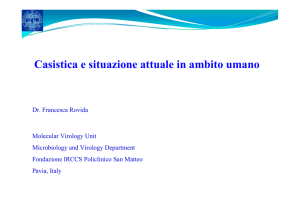

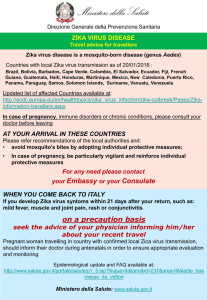
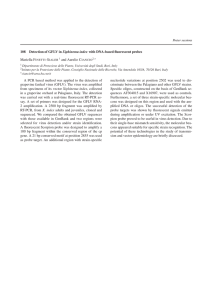
![Yellow-Fever_SA_2012-Ox_CNV [Converted]](http://s1.studylibit.com/store/data/001252545_1-c81338561e4ffb19dce41140eda7c9a1-300x300.png)
